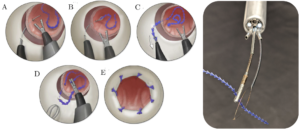Home » Supported Research » Robot-enabled natural orifice prostatectomy
Robot-enabled natural orifice prostatectomy
Title:
Robot-enabled natural orifice prostatectomy
Project Number:
5R01EB026901-02
Contact PI/Project Lead:
Robert Webster
Award Organization:
National Institutes of Health
Abstract:
The objective of this proposal is to create a hand-held surgical robot for endoscopic transurethral radical prostatectomy. The new robot will deploy needle-sized arms through the endoscope, for independent tissue manipulation, laser aiming, and visualization, enabling resection of the prostate and reconstructive suturing. Clinical significance comes from (1) the large number of patients who could benefit (1 in 7 men will have prostate cancer in their lives; 161,000 new cases per year in the USA; 90,000 surgeries per year in the USA), and (2) the high morbidity of current surgical approaches (70% impotence, 21% incontinence, with 39% requiring a subsequent intervention to address complications, and a 1 in 5000 mortality rate). We hypothesize that the key to reducing rates of impotence, incontinence, and complications is minimal disruption to the delicate tissues surrounding the prostate, especially the neurovascular bundles that run on the outside of the prostate and control erectile function and the external sphincter that enables continence. Yet current surgical techniques approach the prostate from the abdomen, and thus require large dissection of the structures that surround the prostate in- cluding endopelvic fascia and prostatic ligaments, and manipulation and retraction of the neurovascular bundles. In contrast, we propose the novel approach of reaching the prostate from within, through the urethra, which is enabled by needle-size, tentacle-like robot manipulators delivered through an endoscope, to enable laser-based resection and dexterous reconstructive suturing. We hypothesize that such a system will improve functional out- comes and reduce complication rates, providing a much less invasive approach to performing prostate surgery. The innovation of our new robot is the ability to deliver needle-sized robotic arms through an endoscope. They are made up of telescoping, curved, elastic tubes. By axially rotating these tubes and telescopically extending them, our robot will provide the surgeon with two small tentacle-like arms at the tip of the endoscope. One arm will carry a holmium laser fiber for cutting, the other will enable tissue retraction, and both will work together to perform reconstructive suturing. This is the first hand-held robotic system to provide two-handed dexterity. It will enable suturing within a lumen as small as the urethra, a major technical innovation that we expect to be useful in many other surgical contexts in the future. Our approach consists of three Specific Aims. Aim 1 addresses the mechanical design of a sterilizable, hand- held robotic system suitable for the workflow of a real-world operating room. Aim 2 focuses on designing con- centric tube manipulators with novel needles and graspers at their tips that enable reconstructive suturing (anas- tomosis) from within the lumen to be repaired. Aim 3 consists of phantom, ex vivo animal tissue, and cadaver studies to experimentally validate our new transurethral approach to radical prostatectomy, evaluating resection quality via medical imaging and reconstruction quality via fluid testing.
